HR Strategies and Practices of Unilever in India: A Study on Value Creation
VerifiedAdded on 2022/12/30
|14
|4263
|79
AI Summary
This report examines the HR strategies and practices of Unilever in India and their role in value creation. It explores the impact of regional and national culture on HRM practices, the employment model and organizational levers used by Unilever, and Storey's 27 points of difference for benchmarking HRM and Personnel Management. The importance of local culture in HR practices like hiring and firing is also discussed.
Contribute Materials
Your contribution can guide someone’s learning journey. Share your
documents today.

Human Resource
Management
Management
Secure Best Marks with AI Grader
Need help grading? Try our AI Grader for instant feedback on your assignments.
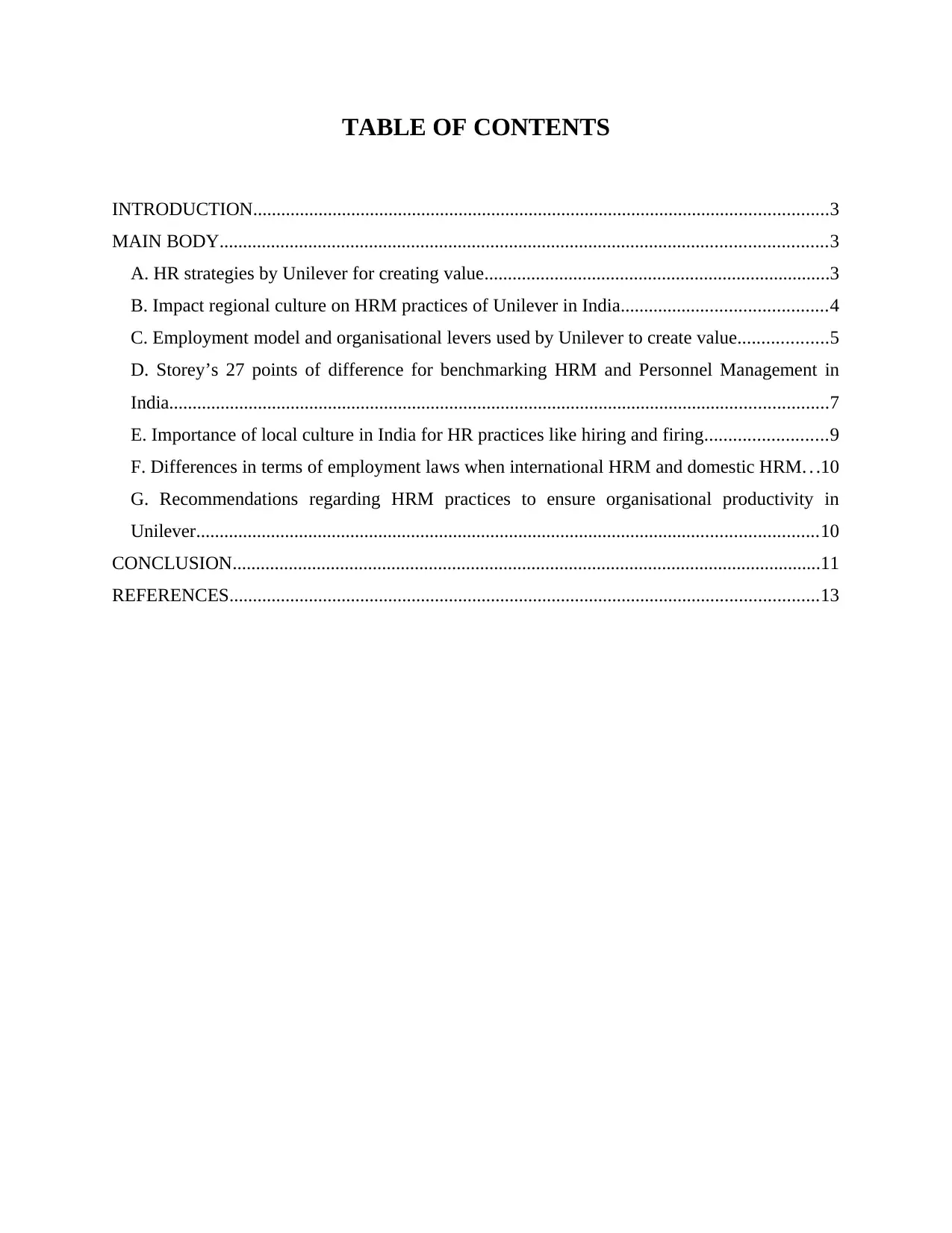
TABLE OF CONTENTS
INTRODUCTION...........................................................................................................................3
MAIN BODY..................................................................................................................................3
A. HR strategies by Unilever for creating value..........................................................................3
B. Impact regional culture on HRM practices of Unilever in India............................................4
C. Employment model and organisational levers used by Unilever to create value...................5
D. Storey’s 27 points of difference for benchmarking HRM and Personnel Management in
India.............................................................................................................................................7
E. Importance of local culture in India for HR practices like hiring and firing..........................9
F. Differences in terms of employment laws when international HRM and domestic HRM. . .10
G. Recommendations regarding HRM practices to ensure organisational productivity in
Unilever.....................................................................................................................................10
CONCLUSION..............................................................................................................................11
REFERENCES..............................................................................................................................13
INTRODUCTION...........................................................................................................................3
MAIN BODY..................................................................................................................................3
A. HR strategies by Unilever for creating value..........................................................................3
B. Impact regional culture on HRM practices of Unilever in India............................................4
C. Employment model and organisational levers used by Unilever to create value...................5
D. Storey’s 27 points of difference for benchmarking HRM and Personnel Management in
India.............................................................................................................................................7
E. Importance of local culture in India for HR practices like hiring and firing..........................9
F. Differences in terms of employment laws when international HRM and domestic HRM. . .10
G. Recommendations regarding HRM practices to ensure organisational productivity in
Unilever.....................................................................................................................................10
CONCLUSION..............................................................................................................................11
REFERENCES..............................................................................................................................13
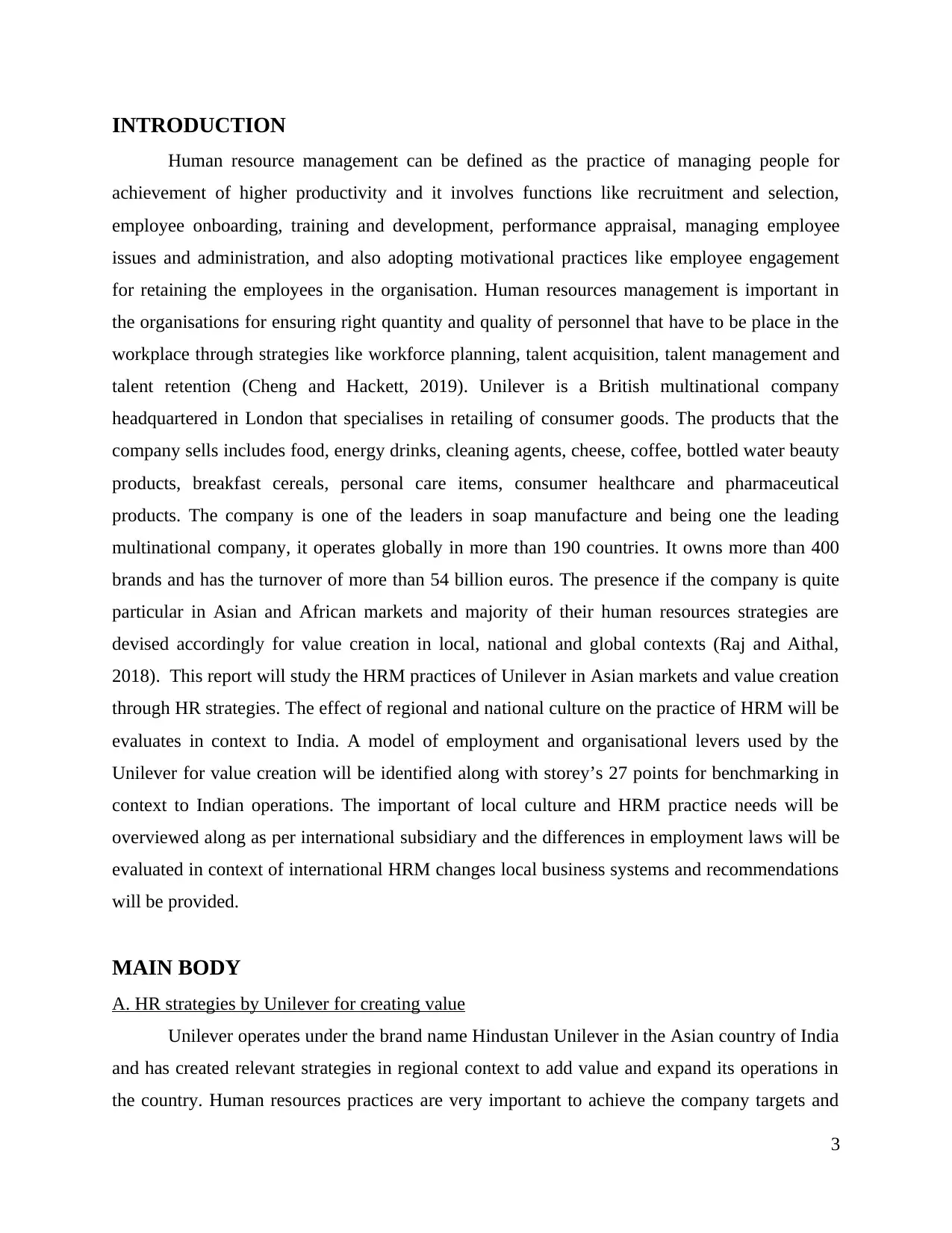
INTRODUCTION
Human resource management can be defined as the practice of managing people for
achievement of higher productivity and it involves functions like recruitment and selection,
employee onboarding, training and development, performance appraisal, managing employee
issues and administration, and also adopting motivational practices like employee engagement
for retaining the employees in the organisation. Human resources management is important in
the organisations for ensuring right quantity and quality of personnel that have to be place in the
workplace through strategies like workforce planning, talent acquisition, talent management and
talent retention (Cheng and Hackett, 2019). Unilever is a British multinational company
headquartered in London that specialises in retailing of consumer goods. The products that the
company sells includes food, energy drinks, cleaning agents, cheese, coffee, bottled water beauty
products, breakfast cereals, personal care items, consumer healthcare and pharmaceutical
products. The company is one of the leaders in soap manufacture and being one the leading
multinational company, it operates globally in more than 190 countries. It owns more than 400
brands and has the turnover of more than 54 billion euros. The presence if the company is quite
particular in Asian and African markets and majority of their human resources strategies are
devised accordingly for value creation in local, national and global contexts (Raj and Aithal,
2018). This report will study the HRM practices of Unilever in Asian markets and value creation
through HR strategies. The effect of regional and national culture on the practice of HRM will be
evaluates in context to India. A model of employment and organisational levers used by the
Unilever for value creation will be identified along with storey’s 27 points for benchmarking in
context to Indian operations. The important of local culture and HRM practice needs will be
overviewed along as per international subsidiary and the differences in employment laws will be
evaluated in context of international HRM changes local business systems and recommendations
will be provided.
MAIN BODY
A. HR strategies by Unilever for creating value
Unilever operates under the brand name Hindustan Unilever in the Asian country of India
and has created relevant strategies in regional context to add value and expand its operations in
the country. Human resources practices are very important to achieve the company targets and
3
Human resource management can be defined as the practice of managing people for
achievement of higher productivity and it involves functions like recruitment and selection,
employee onboarding, training and development, performance appraisal, managing employee
issues and administration, and also adopting motivational practices like employee engagement
for retaining the employees in the organisation. Human resources management is important in
the organisations for ensuring right quantity and quality of personnel that have to be place in the
workplace through strategies like workforce planning, talent acquisition, talent management and
talent retention (Cheng and Hackett, 2019). Unilever is a British multinational company
headquartered in London that specialises in retailing of consumer goods. The products that the
company sells includes food, energy drinks, cleaning agents, cheese, coffee, bottled water beauty
products, breakfast cereals, personal care items, consumer healthcare and pharmaceutical
products. The company is one of the leaders in soap manufacture and being one the leading
multinational company, it operates globally in more than 190 countries. It owns more than 400
brands and has the turnover of more than 54 billion euros. The presence if the company is quite
particular in Asian and African markets and majority of their human resources strategies are
devised accordingly for value creation in local, national and global contexts (Raj and Aithal,
2018). This report will study the HRM practices of Unilever in Asian markets and value creation
through HR strategies. The effect of regional and national culture on the practice of HRM will be
evaluates in context to India. A model of employment and organisational levers used by the
Unilever for value creation will be identified along with storey’s 27 points for benchmarking in
context to Indian operations. The important of local culture and HRM practice needs will be
overviewed along as per international subsidiary and the differences in employment laws will be
evaluated in context of international HRM changes local business systems and recommendations
will be provided.
MAIN BODY
A. HR strategies by Unilever for creating value
Unilever operates under the brand name Hindustan Unilever in the Asian country of India
and has created relevant strategies in regional context to add value and expand its operations in
the country. Human resources practices are very important to achieve the company targets and
3
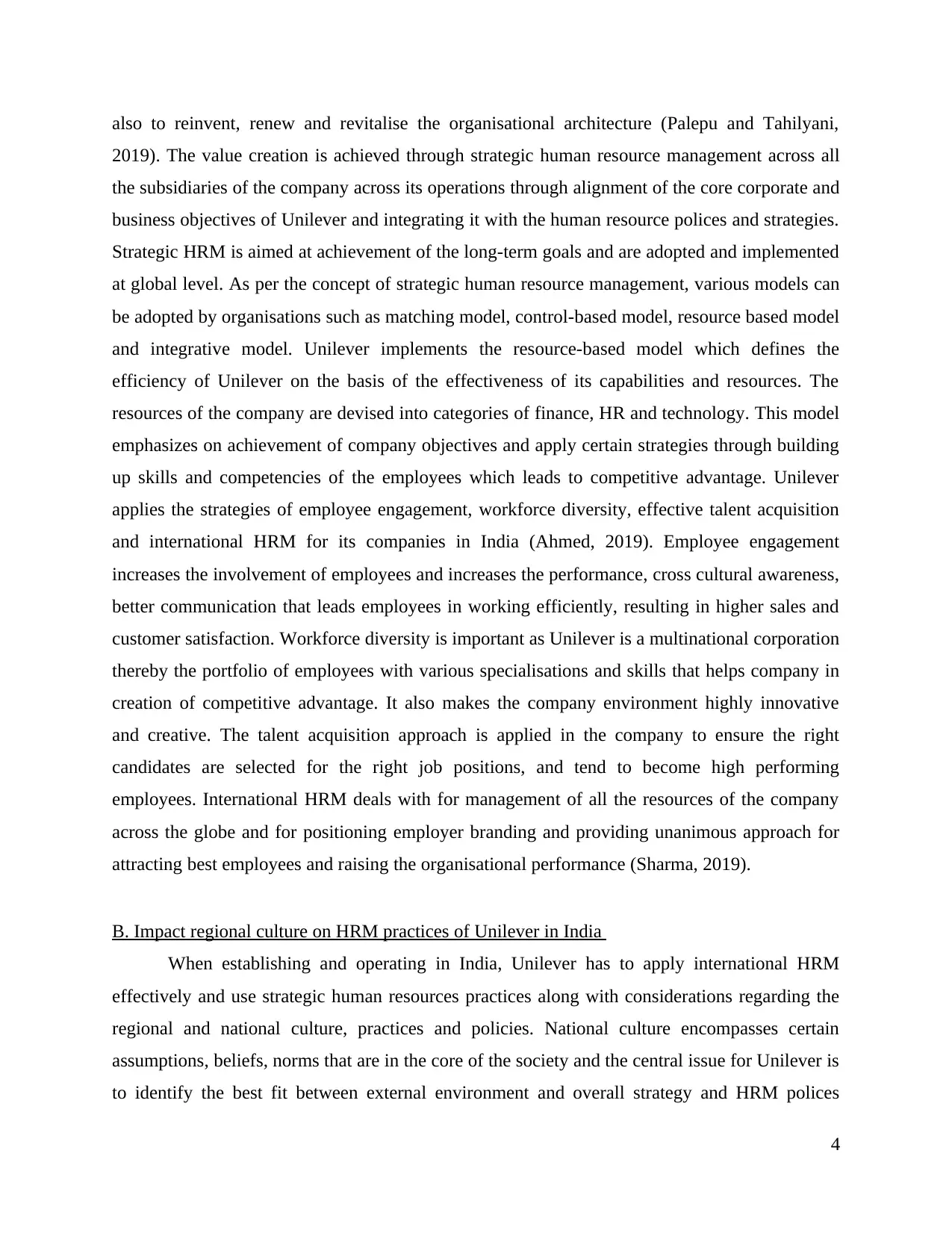
also to reinvent, renew and revitalise the organisational architecture (Palepu and Tahilyani,
2019). The value creation is achieved through strategic human resource management across all
the subsidiaries of the company across its operations through alignment of the core corporate and
business objectives of Unilever and integrating it with the human resource polices and strategies.
Strategic HRM is aimed at achievement of the long-term goals and are adopted and implemented
at global level. As per the concept of strategic human resource management, various models can
be adopted by organisations such as matching model, control-based model, resource based model
and integrative model. Unilever implements the resource-based model which defines the
efficiency of Unilever on the basis of the effectiveness of its capabilities and resources. The
resources of the company are devised into categories of finance, HR and technology. This model
emphasizes on achievement of company objectives and apply certain strategies through building
up skills and competencies of the employees which leads to competitive advantage. Unilever
applies the strategies of employee engagement, workforce diversity, effective talent acquisition
and international HRM for its companies in India (Ahmed, 2019). Employee engagement
increases the involvement of employees and increases the performance, cross cultural awareness,
better communication that leads employees in working efficiently, resulting in higher sales and
customer satisfaction. Workforce diversity is important as Unilever is a multinational corporation
thereby the portfolio of employees with various specialisations and skills that helps company in
creation of competitive advantage. It also makes the company environment highly innovative
and creative. The talent acquisition approach is applied in the company to ensure the right
candidates are selected for the right job positions, and tend to become high performing
employees. International HRM deals with for management of all the resources of the company
across the globe and for positioning employer branding and providing unanimous approach for
attracting best employees and raising the organisational performance (Sharma, 2019).
B. Impact regional culture on HRM practices of Unilever in India
When establishing and operating in India, Unilever has to apply international HRM
effectively and use strategic human resources practices along with considerations regarding the
regional and national culture, practices and policies. National culture encompasses certain
assumptions, beliefs, norms that are in the core of the society and the central issue for Unilever is
to identify the best fit between external environment and overall strategy and HRM polices
4
2019). The value creation is achieved through strategic human resource management across all
the subsidiaries of the company across its operations through alignment of the core corporate and
business objectives of Unilever and integrating it with the human resource polices and strategies.
Strategic HRM is aimed at achievement of the long-term goals and are adopted and implemented
at global level. As per the concept of strategic human resource management, various models can
be adopted by organisations such as matching model, control-based model, resource based model
and integrative model. Unilever implements the resource-based model which defines the
efficiency of Unilever on the basis of the effectiveness of its capabilities and resources. The
resources of the company are devised into categories of finance, HR and technology. This model
emphasizes on achievement of company objectives and apply certain strategies through building
up skills and competencies of the employees which leads to competitive advantage. Unilever
applies the strategies of employee engagement, workforce diversity, effective talent acquisition
and international HRM for its companies in India (Ahmed, 2019). Employee engagement
increases the involvement of employees and increases the performance, cross cultural awareness,
better communication that leads employees in working efficiently, resulting in higher sales and
customer satisfaction. Workforce diversity is important as Unilever is a multinational corporation
thereby the portfolio of employees with various specialisations and skills that helps company in
creation of competitive advantage. It also makes the company environment highly innovative
and creative. The talent acquisition approach is applied in the company to ensure the right
candidates are selected for the right job positions, and tend to become high performing
employees. International HRM deals with for management of all the resources of the company
across the globe and for positioning employer branding and providing unanimous approach for
attracting best employees and raising the organisational performance (Sharma, 2019).
B. Impact regional culture on HRM practices of Unilever in India
When establishing and operating in India, Unilever has to apply international HRM
effectively and use strategic human resources practices along with considerations regarding the
regional and national culture, practices and policies. National culture encompasses certain
assumptions, beliefs, norms that are in the core of the society and the central issue for Unilever is
to identify the best fit between external environment and overall strategy and HRM polices
4
Secure Best Marks with AI Grader
Need help grading? Try our AI Grader for instant feedback on your assignments.
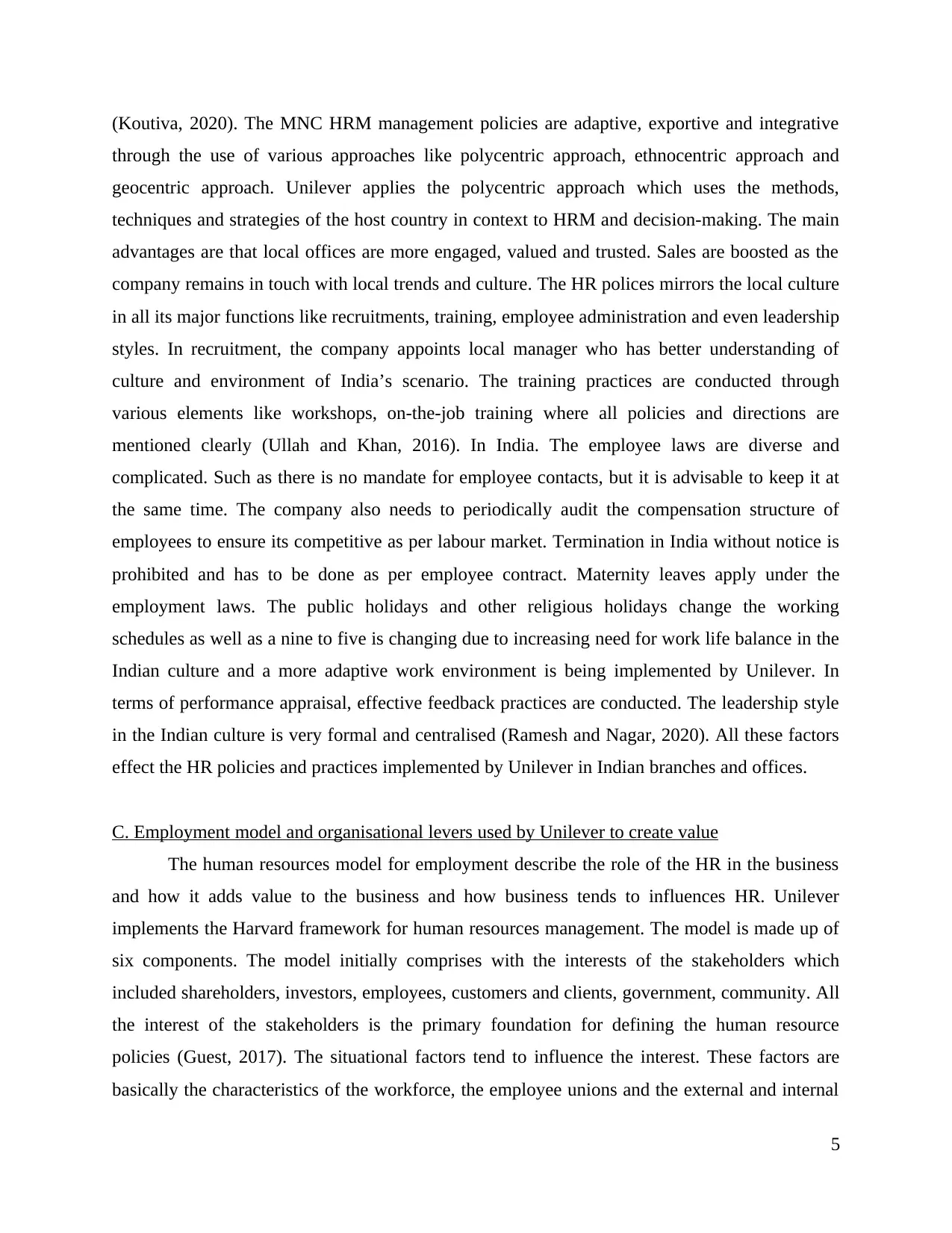
(Koutiva, 2020). The MNC HRM management policies are adaptive, exportive and integrative
through the use of various approaches like polycentric approach, ethnocentric approach and
geocentric approach. Unilever applies the polycentric approach which uses the methods,
techniques and strategies of the host country in context to HRM and decision-making. The main
advantages are that local offices are more engaged, valued and trusted. Sales are boosted as the
company remains in touch with local trends and culture. The HR polices mirrors the local culture
in all its major functions like recruitments, training, employee administration and even leadership
styles. In recruitment, the company appoints local manager who has better understanding of
culture and environment of India’s scenario. The training practices are conducted through
various elements like workshops, on-the-job training where all policies and directions are
mentioned clearly (Ullah and Khan, 2016). In India. The employee laws are diverse and
complicated. Such as there is no mandate for employee contacts, but it is advisable to keep it at
the same time. The company also needs to periodically audit the compensation structure of
employees to ensure its competitive as per labour market. Termination in India without notice is
prohibited and has to be done as per employee contract. Maternity leaves apply under the
employment laws. The public holidays and other religious holidays change the working
schedules as well as a nine to five is changing due to increasing need for work life balance in the
Indian culture and a more adaptive work environment is being implemented by Unilever. In
terms of performance appraisal, effective feedback practices are conducted. The leadership style
in the Indian culture is very formal and centralised (Ramesh and Nagar, 2020). All these factors
effect the HR policies and practices implemented by Unilever in Indian branches and offices.
C. Employment model and organisational levers used by Unilever to create value
The human resources model for employment describe the role of the HR in the business
and how it adds value to the business and how business tends to influences HR. Unilever
implements the Harvard framework for human resources management. The model is made up of
six components. The model initially comprises with the interests of the stakeholders which
included shareholders, investors, employees, customers and clients, government, community. All
the interest of the stakeholders is the primary foundation for defining the human resource
policies (Guest, 2017). The situational factors tend to influence the interest. These factors are
basically the characteristics of the workforce, the employee unions and the external and internal
5
through the use of various approaches like polycentric approach, ethnocentric approach and
geocentric approach. Unilever applies the polycentric approach which uses the methods,
techniques and strategies of the host country in context to HRM and decision-making. The main
advantages are that local offices are more engaged, valued and trusted. Sales are boosted as the
company remains in touch with local trends and culture. The HR polices mirrors the local culture
in all its major functions like recruitments, training, employee administration and even leadership
styles. In recruitment, the company appoints local manager who has better understanding of
culture and environment of India’s scenario. The training practices are conducted through
various elements like workshops, on-the-job training where all policies and directions are
mentioned clearly (Ullah and Khan, 2016). In India. The employee laws are diverse and
complicated. Such as there is no mandate for employee contacts, but it is advisable to keep it at
the same time. The company also needs to periodically audit the compensation structure of
employees to ensure its competitive as per labour market. Termination in India without notice is
prohibited and has to be done as per employee contract. Maternity leaves apply under the
employment laws. The public holidays and other religious holidays change the working
schedules as well as a nine to five is changing due to increasing need for work life balance in the
Indian culture and a more adaptive work environment is being implemented by Unilever. In
terms of performance appraisal, effective feedback practices are conducted. The leadership style
in the Indian culture is very formal and centralised (Ramesh and Nagar, 2020). All these factors
effect the HR policies and practices implemented by Unilever in Indian branches and offices.
C. Employment model and organisational levers used by Unilever to create value
The human resources model for employment describe the role of the HR in the business
and how it adds value to the business and how business tends to influences HR. Unilever
implements the Harvard framework for human resources management. The model is made up of
six components. The model initially comprises with the interests of the stakeholders which
included shareholders, investors, employees, customers and clients, government, community. All
the interest of the stakeholders is the primary foundation for defining the human resource
policies (Guest, 2017). The situational factors tend to influence the interest. These factors are
basically the characteristics of the workforce, the employee unions and the external and internal
5
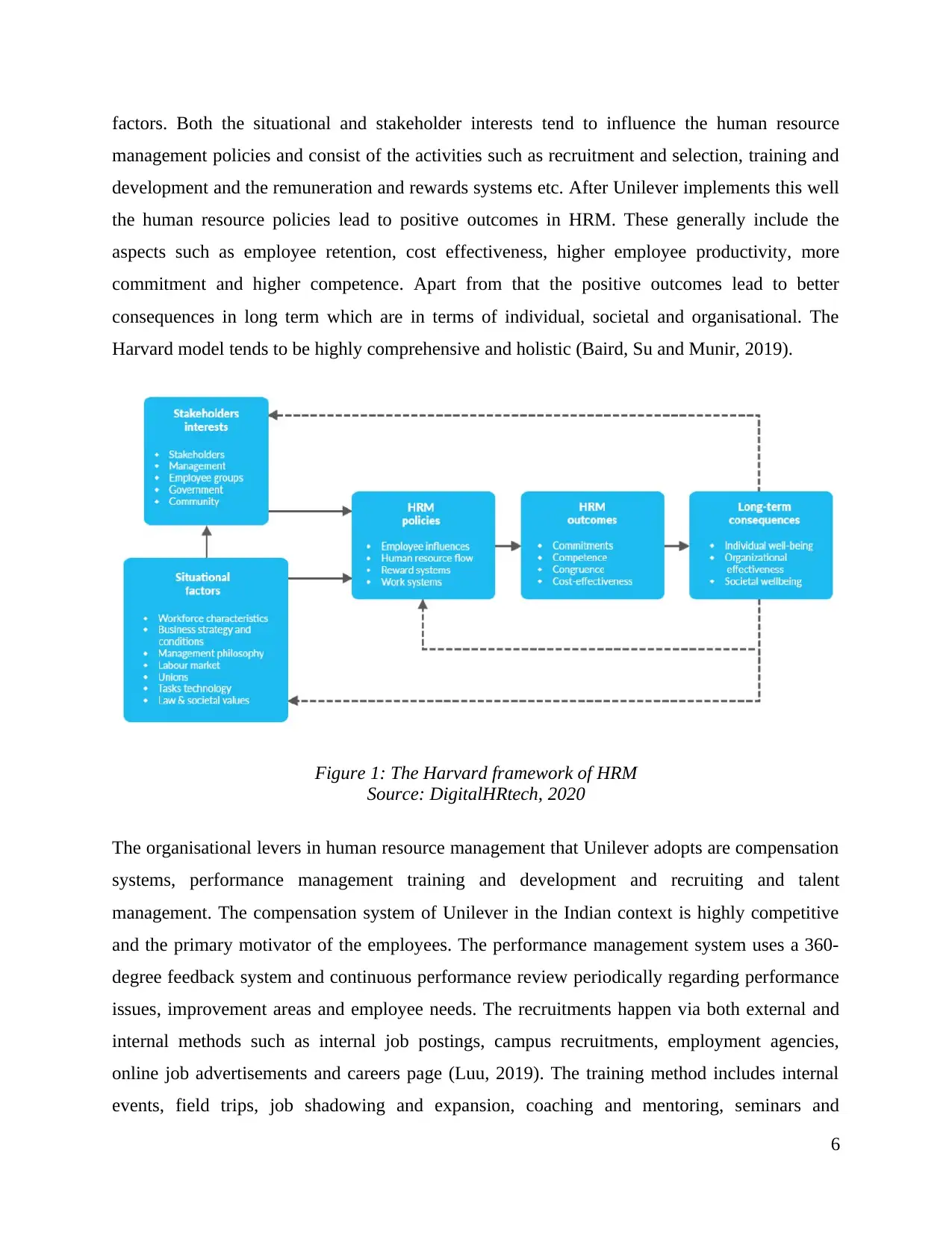
factors. Both the situational and stakeholder interests tend to influence the human resource
management policies and consist of the activities such as recruitment and selection, training and
development and the remuneration and rewards systems etc. After Unilever implements this well
the human resource policies lead to positive outcomes in HRM. These generally include the
aspects such as employee retention, cost effectiveness, higher employee productivity, more
commitment and higher competence. Apart from that the positive outcomes lead to better
consequences in long term which are in terms of individual, societal and organisational. The
Harvard model tends to be highly comprehensive and holistic (Baird, Su and Munir, 2019).
Figure 1: The Harvard framework of HRM
Source: DigitalHRtech, 2020
The organisational levers in human resource management that Unilever adopts are compensation
systems, performance management training and development and recruiting and talent
management. The compensation system of Unilever in the Indian context is highly competitive
and the primary motivator of the employees. The performance management system uses a 360-
degree feedback system and continuous performance review periodically regarding performance
issues, improvement areas and employee needs. The recruitments happen via both external and
internal methods such as internal job postings, campus recruitments, employment agencies,
online job advertisements and careers page (Luu, 2019). The training method includes internal
events, field trips, job shadowing and expansion, coaching and mentoring, seminars and
6
management policies and consist of the activities such as recruitment and selection, training and
development and the remuneration and rewards systems etc. After Unilever implements this well
the human resource policies lead to positive outcomes in HRM. These generally include the
aspects such as employee retention, cost effectiveness, higher employee productivity, more
commitment and higher competence. Apart from that the positive outcomes lead to better
consequences in long term which are in terms of individual, societal and organisational. The
Harvard model tends to be highly comprehensive and holistic (Baird, Su and Munir, 2019).
Figure 1: The Harvard framework of HRM
Source: DigitalHRtech, 2020
The organisational levers in human resource management that Unilever adopts are compensation
systems, performance management training and development and recruiting and talent
management. The compensation system of Unilever in the Indian context is highly competitive
and the primary motivator of the employees. The performance management system uses a 360-
degree feedback system and continuous performance review periodically regarding performance
issues, improvement areas and employee needs. The recruitments happen via both external and
internal methods such as internal job postings, campus recruitments, employment agencies,
online job advertisements and careers page (Luu, 2019). The training method includes internal
events, field trips, job shadowing and expansion, coaching and mentoring, seminars and
6
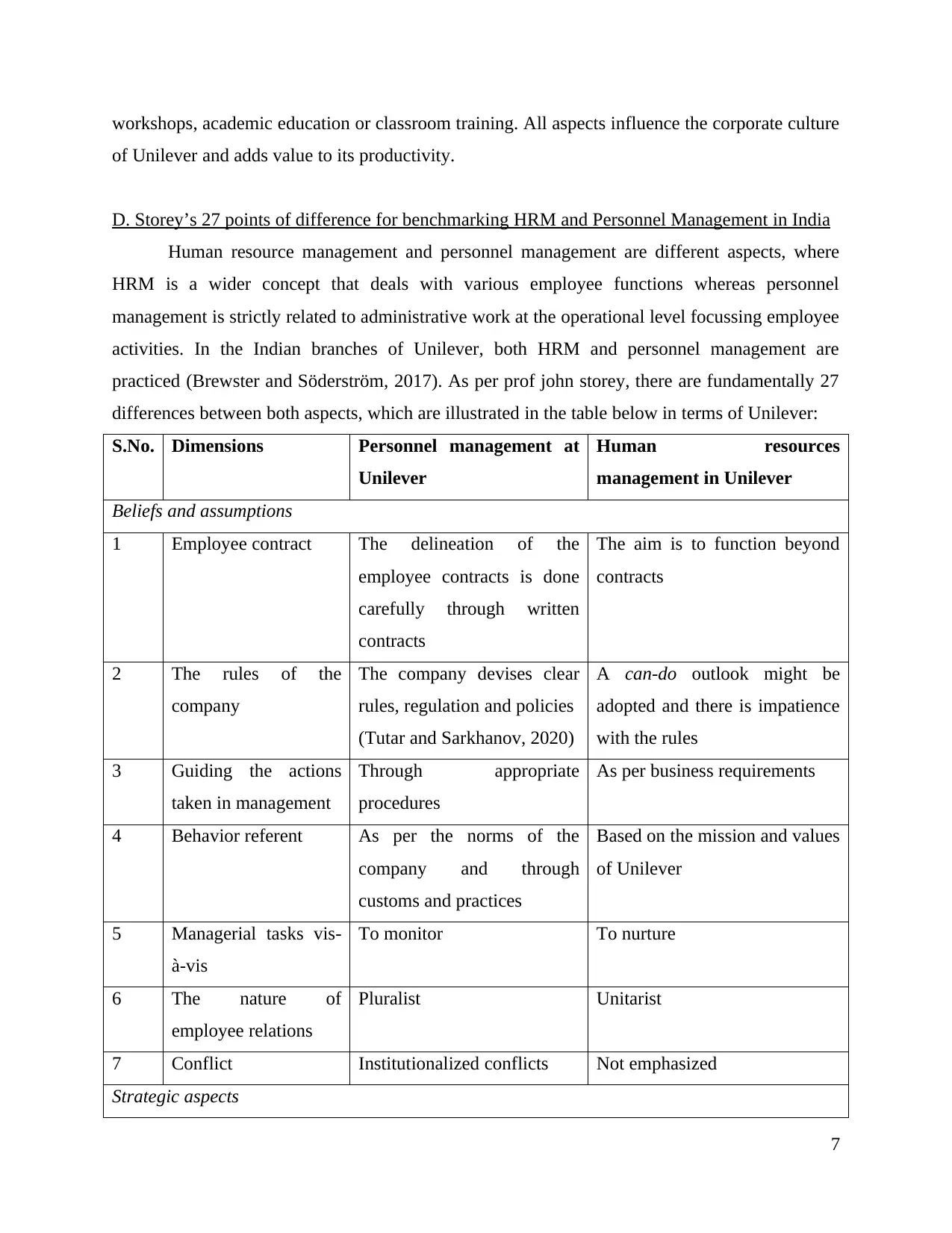
workshops, academic education or classroom training. All aspects influence the corporate culture
of Unilever and adds value to its productivity.
D. Storey’s 27 points of difference for benchmarking HRM and Personnel Management in India
Human resource management and personnel management are different aspects, where
HRM is a wider concept that deals with various employee functions whereas personnel
management is strictly related to administrative work at the operational level focussing employee
activities. In the Indian branches of Unilever, both HRM and personnel management are
practiced (Brewster and Söderström, 2017). As per prof john storey, there are fundamentally 27
differences between both aspects, which are illustrated in the table below in terms of Unilever:
S.No. Dimensions Personnel management at
Unilever
Human resources
management in Unilever
Beliefs and assumptions
1 Employee contract The delineation of the
employee contracts is done
carefully through written
contracts
The aim is to function beyond
contracts
2 The rules of the
company
The company devises clear
rules, regulation and policies
(Tutar and Sarkhanov, 2020)
A can-do outlook might be
adopted and there is impatience
with the rules
3 Guiding the actions
taken in management
Through appropriate
procedures
As per business requirements
4 Behavior referent As per the norms of the
company and through
customs and practices
Based on the mission and values
of Unilever
5 Managerial tasks vis-
à-vis
To monitor To nurture
6 The nature of
employee relations
Pluralist Unitarist
7 Conflict Institutionalized conflicts Not emphasized
Strategic aspects
7
of Unilever and adds value to its productivity.
D. Storey’s 27 points of difference for benchmarking HRM and Personnel Management in India
Human resource management and personnel management are different aspects, where
HRM is a wider concept that deals with various employee functions whereas personnel
management is strictly related to administrative work at the operational level focussing employee
activities. In the Indian branches of Unilever, both HRM and personnel management are
practiced (Brewster and Söderström, 2017). As per prof john storey, there are fundamentally 27
differences between both aspects, which are illustrated in the table below in terms of Unilever:
S.No. Dimensions Personnel management at
Unilever
Human resources
management in Unilever
Beliefs and assumptions
1 Employee contract The delineation of the
employee contracts is done
carefully through written
contracts
The aim is to function beyond
contracts
2 The rules of the
company
The company devises clear
rules, regulation and policies
(Tutar and Sarkhanov, 2020)
A can-do outlook might be
adopted and there is impatience
with the rules
3 Guiding the actions
taken in management
Through appropriate
procedures
As per business requirements
4 Behavior referent As per the norms of the
company and through
customs and practices
Based on the mission and values
of Unilever
5 Managerial tasks vis-
à-vis
To monitor To nurture
6 The nature of
employee relations
Pluralist Unitarist
7 Conflict Institutionalized conflicts Not emphasized
Strategic aspects
7
Paraphrase This Document
Need a fresh take? Get an instant paraphrase of this document with our AI Paraphraser
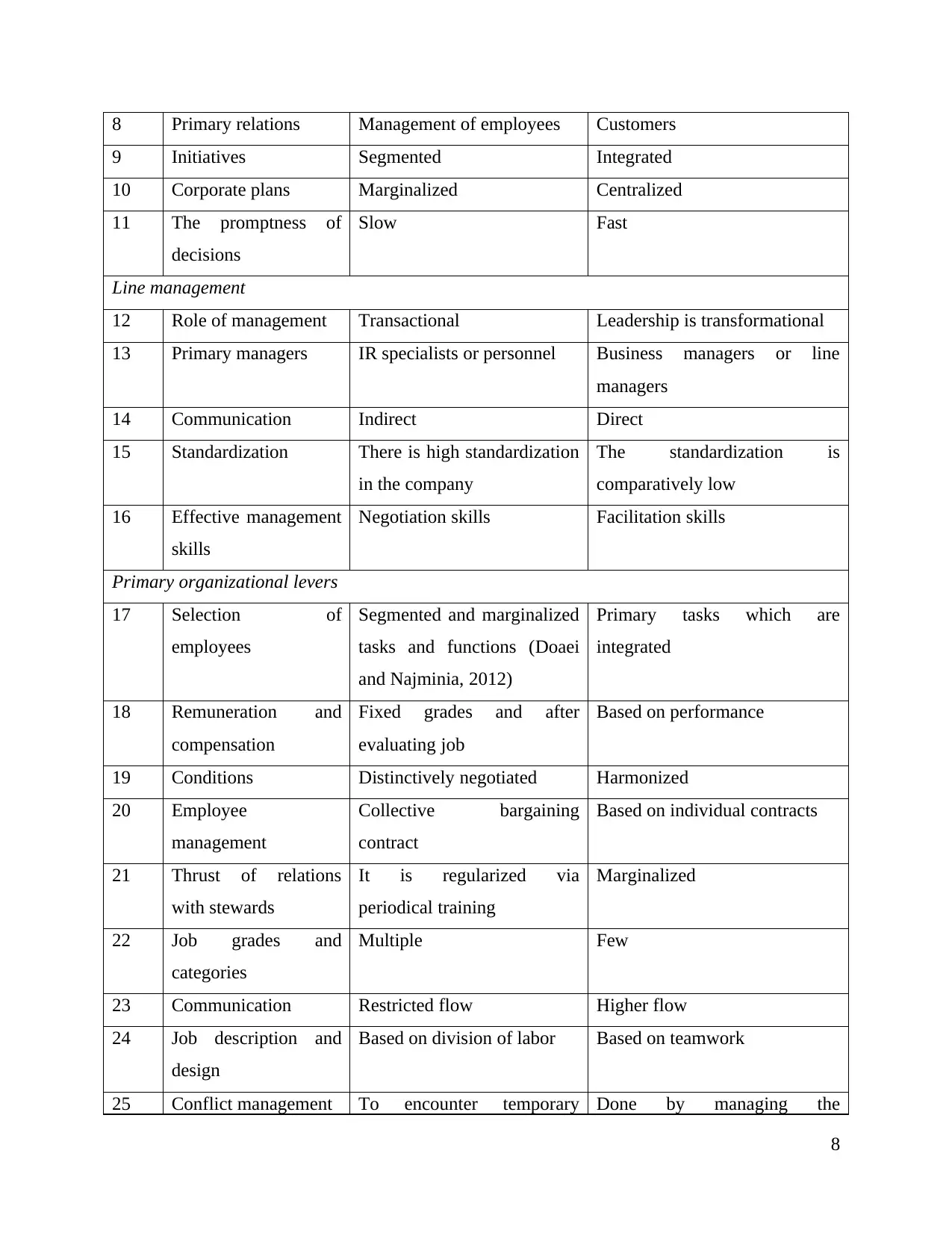
8 Primary relations Management of employees Customers
9 Initiatives Segmented Integrated
10 Corporate plans Marginalized Centralized
11 The promptness of
decisions
Slow Fast
Line management
12 Role of management Transactional Leadership is transformational
13 Primary managers IR specialists or personnel Business managers or line
managers
14 Communication Indirect Direct
15 Standardization There is high standardization
in the company
The standardization is
comparatively low
16 Effective management
skills
Negotiation skills Facilitation skills
Primary organizational levers
17 Selection of
employees
Segmented and marginalized
tasks and functions (Doaei
and Najminia, 2012)
Primary tasks which are
integrated
18 Remuneration and
compensation
Fixed grades and after
evaluating job
Based on performance
19 Conditions Distinctively negotiated Harmonized
20 Employee
management
Collective bargaining
contract
Based on individual contracts
21 Thrust of relations
with stewards
It is regularized via
periodical training
Marginalized
22 Job grades and
categories
Multiple Few
23 Communication Restricted flow Higher flow
24 Job description and
design
Based on division of labor Based on teamwork
25 Conflict management To encounter temporary Done by managing the
8
9 Initiatives Segmented Integrated
10 Corporate plans Marginalized Centralized
11 The promptness of
decisions
Slow Fast
Line management
12 Role of management Transactional Leadership is transformational
13 Primary managers IR specialists or personnel Business managers or line
managers
14 Communication Indirect Direct
15 Standardization There is high standardization
in the company
The standardization is
comparatively low
16 Effective management
skills
Negotiation skills Facilitation skills
Primary organizational levers
17 Selection of
employees
Segmented and marginalized
tasks and functions (Doaei
and Najminia, 2012)
Primary tasks which are
integrated
18 Remuneration and
compensation
Fixed grades and after
evaluating job
Based on performance
19 Conditions Distinctively negotiated Harmonized
20 Employee
management
Collective bargaining
contract
Based on individual contracts
21 Thrust of relations
with stewards
It is regularized via
periodical training
Marginalized
22 Job grades and
categories
Multiple Few
23 Communication Restricted flow Higher flow
24 Job description and
design
Based on division of labor Based on teamwork
25 Conflict management To encounter temporary Done by managing the
8
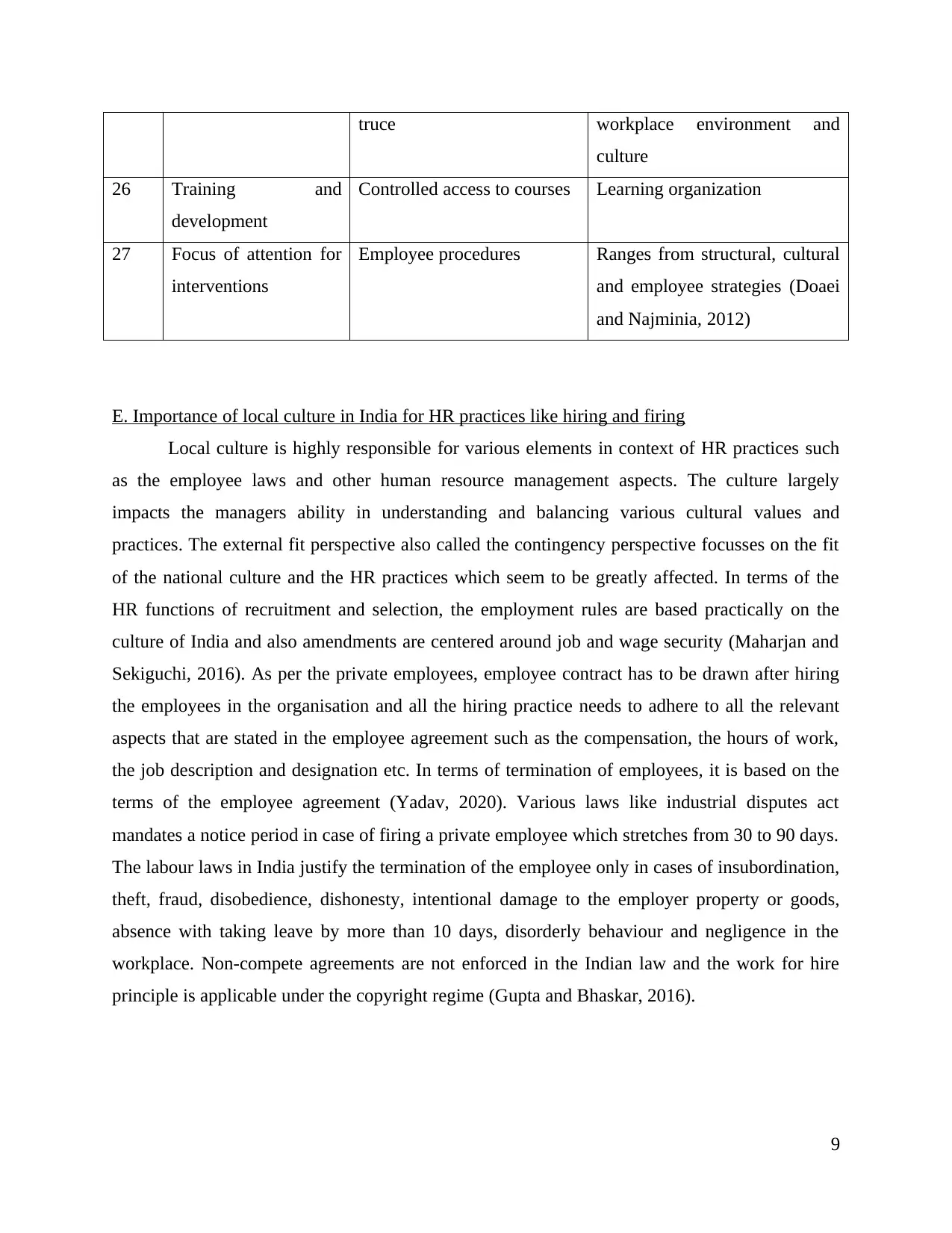
truce workplace environment and
culture
26 Training and
development
Controlled access to courses Learning organization
27 Focus of attention for
interventions
Employee procedures Ranges from structural, cultural
and employee strategies (Doaei
and Najminia, 2012)
E. Importance of local culture in India for HR practices like hiring and firing
Local culture is highly responsible for various elements in context of HR practices such
as the employee laws and other human resource management aspects. The culture largely
impacts the managers ability in understanding and balancing various cultural values and
practices. The external fit perspective also called the contingency perspective focusses on the fit
of the national culture and the HR practices which seem to be greatly affected. In terms of the
HR functions of recruitment and selection, the employment rules are based practically on the
culture of India and also amendments are centered around job and wage security (Maharjan and
Sekiguchi, 2016). As per the private employees, employee contract has to be drawn after hiring
the employees in the organisation and all the hiring practice needs to adhere to all the relevant
aspects that are stated in the employee agreement such as the compensation, the hours of work,
the job description and designation etc. In terms of termination of employees, it is based on the
terms of the employee agreement (Yadav, 2020). Various laws like industrial disputes act
mandates a notice period in case of firing a private employee which stretches from 30 to 90 days.
The labour laws in India justify the termination of the employee only in cases of insubordination,
theft, fraud, disobedience, dishonesty, intentional damage to the employer property or goods,
absence with taking leave by more than 10 days, disorderly behaviour and negligence in the
workplace. Non-compete agreements are not enforced in the Indian law and the work for hire
principle is applicable under the copyright regime (Gupta and Bhaskar, 2016).
9
culture
26 Training and
development
Controlled access to courses Learning organization
27 Focus of attention for
interventions
Employee procedures Ranges from structural, cultural
and employee strategies (Doaei
and Najminia, 2012)
E. Importance of local culture in India for HR practices like hiring and firing
Local culture is highly responsible for various elements in context of HR practices such
as the employee laws and other human resource management aspects. The culture largely
impacts the managers ability in understanding and balancing various cultural values and
practices. The external fit perspective also called the contingency perspective focusses on the fit
of the national culture and the HR practices which seem to be greatly affected. In terms of the
HR functions of recruitment and selection, the employment rules are based practically on the
culture of India and also amendments are centered around job and wage security (Maharjan and
Sekiguchi, 2016). As per the private employees, employee contract has to be drawn after hiring
the employees in the organisation and all the hiring practice needs to adhere to all the relevant
aspects that are stated in the employee agreement such as the compensation, the hours of work,
the job description and designation etc. In terms of termination of employees, it is based on the
terms of the employee agreement (Yadav, 2020). Various laws like industrial disputes act
mandates a notice period in case of firing a private employee which stretches from 30 to 90 days.
The labour laws in India justify the termination of the employee only in cases of insubordination,
theft, fraud, disobedience, dishonesty, intentional damage to the employer property or goods,
absence with taking leave by more than 10 days, disorderly behaviour and negligence in the
workplace. Non-compete agreements are not enforced in the Indian law and the work for hire
principle is applicable under the copyright regime (Gupta and Bhaskar, 2016).
9
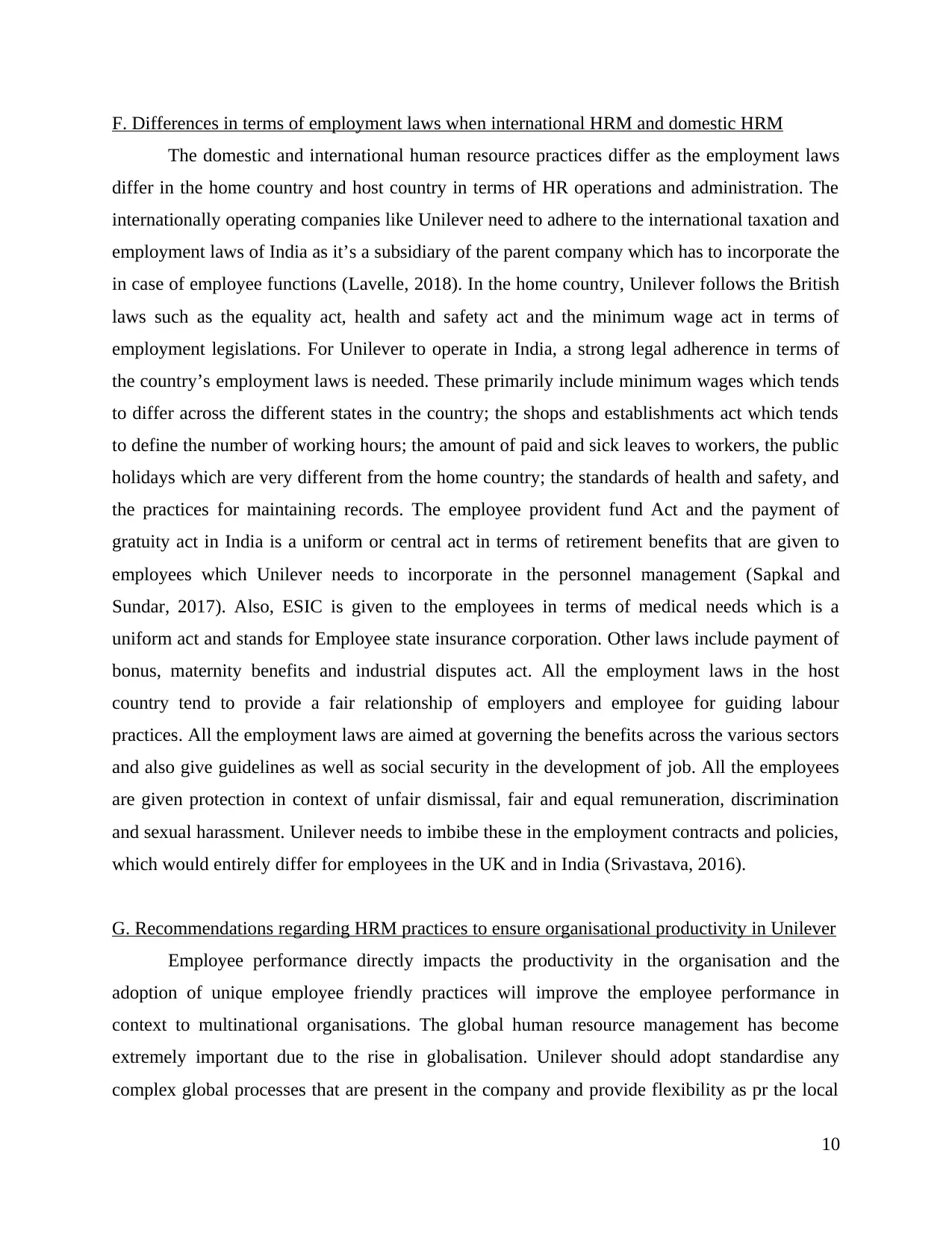
F. Differences in terms of employment laws when international HRM and domestic HRM
The domestic and international human resource practices differ as the employment laws
differ in the home country and host country in terms of HR operations and administration. The
internationally operating companies like Unilever need to adhere to the international taxation and
employment laws of India as it’s a subsidiary of the parent company which has to incorporate the
in case of employee functions (Lavelle, 2018). In the home country, Unilever follows the British
laws such as the equality act, health and safety act and the minimum wage act in terms of
employment legislations. For Unilever to operate in India, a strong legal adherence in terms of
the country’s employment laws is needed. These primarily include minimum wages which tends
to differ across the different states in the country; the shops and establishments act which tends
to define the number of working hours; the amount of paid and sick leaves to workers, the public
holidays which are very different from the home country; the standards of health and safety, and
the practices for maintaining records. The employee provident fund Act and the payment of
gratuity act in India is a uniform or central act in terms of retirement benefits that are given to
employees which Unilever needs to incorporate in the personnel management (Sapkal and
Sundar, 2017). Also, ESIC is given to the employees in terms of medical needs which is a
uniform act and stands for Employee state insurance corporation. Other laws include payment of
bonus, maternity benefits and industrial disputes act. All the employment laws in the host
country tend to provide a fair relationship of employers and employee for guiding labour
practices. All the employment laws are aimed at governing the benefits across the various sectors
and also give guidelines as well as social security in the development of job. All the employees
are given protection in context of unfair dismissal, fair and equal remuneration, discrimination
and sexual harassment. Unilever needs to imbibe these in the employment contracts and policies,
which would entirely differ for employees in the UK and in India (Srivastava, 2016).
G. Recommendations regarding HRM practices to ensure organisational productivity in Unilever
Employee performance directly impacts the productivity in the organisation and the
adoption of unique employee friendly practices will improve the employee performance in
context to multinational organisations. The global human resource management has become
extremely important due to the rise in globalisation. Unilever should adopt standardise any
complex global processes that are present in the company and provide flexibility as pr the local
10
The domestic and international human resource practices differ as the employment laws
differ in the home country and host country in terms of HR operations and administration. The
internationally operating companies like Unilever need to adhere to the international taxation and
employment laws of India as it’s a subsidiary of the parent company which has to incorporate the
in case of employee functions (Lavelle, 2018). In the home country, Unilever follows the British
laws such as the equality act, health and safety act and the minimum wage act in terms of
employment legislations. For Unilever to operate in India, a strong legal adherence in terms of
the country’s employment laws is needed. These primarily include minimum wages which tends
to differ across the different states in the country; the shops and establishments act which tends
to define the number of working hours; the amount of paid and sick leaves to workers, the public
holidays which are very different from the home country; the standards of health and safety, and
the practices for maintaining records. The employee provident fund Act and the payment of
gratuity act in India is a uniform or central act in terms of retirement benefits that are given to
employees which Unilever needs to incorporate in the personnel management (Sapkal and
Sundar, 2017). Also, ESIC is given to the employees in terms of medical needs which is a
uniform act and stands for Employee state insurance corporation. Other laws include payment of
bonus, maternity benefits and industrial disputes act. All the employment laws in the host
country tend to provide a fair relationship of employers and employee for guiding labour
practices. All the employment laws are aimed at governing the benefits across the various sectors
and also give guidelines as well as social security in the development of job. All the employees
are given protection in context of unfair dismissal, fair and equal remuneration, discrimination
and sexual harassment. Unilever needs to imbibe these in the employment contracts and policies,
which would entirely differ for employees in the UK and in India (Srivastava, 2016).
G. Recommendations regarding HRM practices to ensure organisational productivity in Unilever
Employee performance directly impacts the productivity in the organisation and the
adoption of unique employee friendly practices will improve the employee performance in
context to multinational organisations. The global human resource management has become
extremely important due to the rise in globalisation. Unilever should adopt standardise any
complex global processes that are present in the company and provide flexibility as pr the local
10
Secure Best Marks with AI Grader
Need help grading? Try our AI Grader for instant feedback on your assignments.
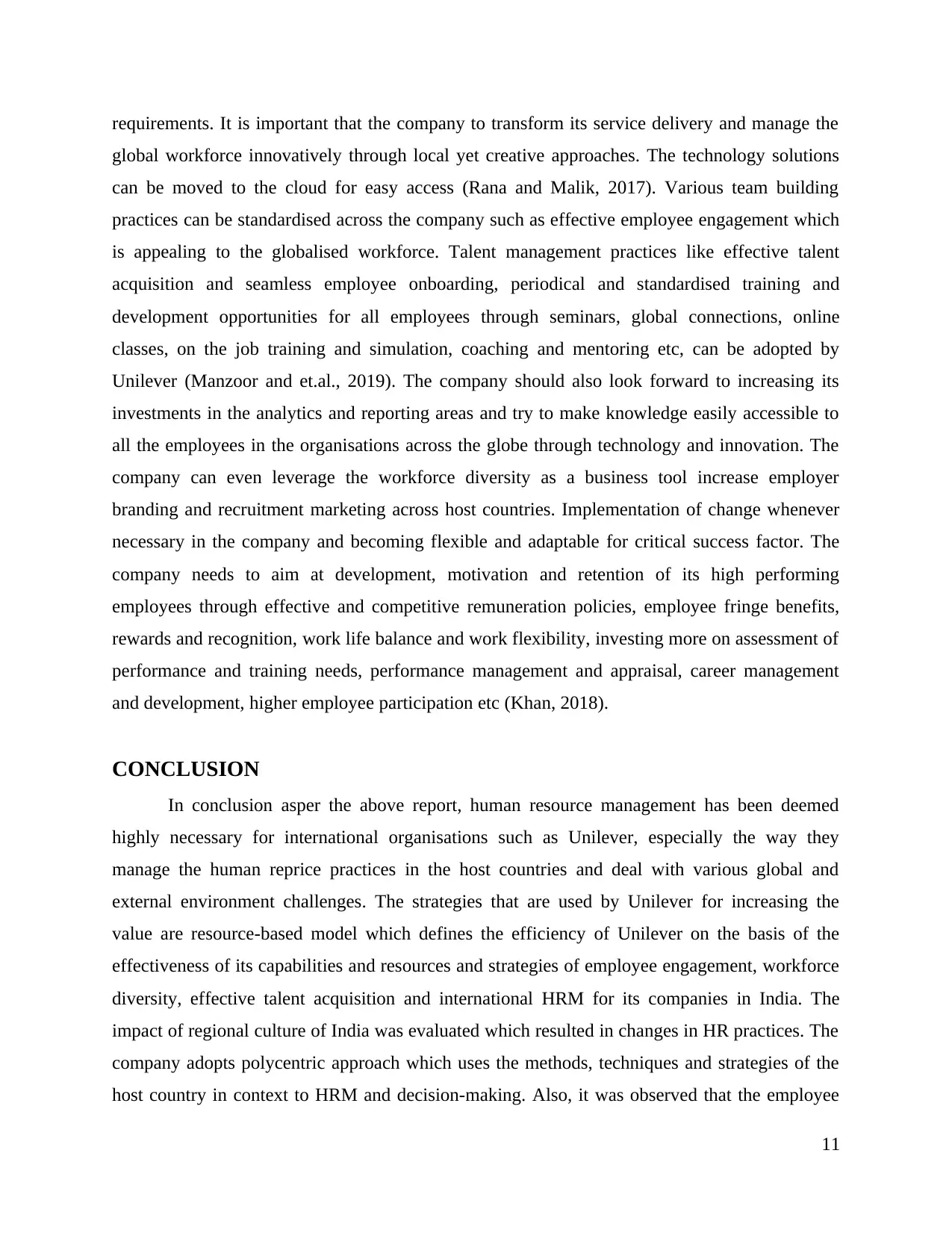
requirements. It is important that the company to transform its service delivery and manage the
global workforce innovatively through local yet creative approaches. The technology solutions
can be moved to the cloud for easy access (Rana and Malik, 2017). Various team building
practices can be standardised across the company such as effective employee engagement which
is appealing to the globalised workforce. Talent management practices like effective talent
acquisition and seamless employee onboarding, periodical and standardised training and
development opportunities for all employees through seminars, global connections, online
classes, on the job training and simulation, coaching and mentoring etc, can be adopted by
Unilever (Manzoor and et.al., 2019). The company should also look forward to increasing its
investments in the analytics and reporting areas and try to make knowledge easily accessible to
all the employees in the organisations across the globe through technology and innovation. The
company can even leverage the workforce diversity as a business tool increase employer
branding and recruitment marketing across host countries. Implementation of change whenever
necessary in the company and becoming flexible and adaptable for critical success factor. The
company needs to aim at development, motivation and retention of its high performing
employees through effective and competitive remuneration policies, employee fringe benefits,
rewards and recognition, work life balance and work flexibility, investing more on assessment of
performance and training needs, performance management and appraisal, career management
and development, higher employee participation etc (Khan, 2018).
CONCLUSION
In conclusion asper the above report, human resource management has been deemed
highly necessary for international organisations such as Unilever, especially the way they
manage the human reprice practices in the host countries and deal with various global and
external environment challenges. The strategies that are used by Unilever for increasing the
value are resource-based model which defines the efficiency of Unilever on the basis of the
effectiveness of its capabilities and resources and strategies of employee engagement, workforce
diversity, effective talent acquisition and international HRM for its companies in India. The
impact of regional culture of India was evaluated which resulted in changes in HR practices. The
company adopts polycentric approach which uses the methods, techniques and strategies of the
host country in context to HRM and decision-making. Also, it was observed that the employee
11
global workforce innovatively through local yet creative approaches. The technology solutions
can be moved to the cloud for easy access (Rana and Malik, 2017). Various team building
practices can be standardised across the company such as effective employee engagement which
is appealing to the globalised workforce. Talent management practices like effective talent
acquisition and seamless employee onboarding, periodical and standardised training and
development opportunities for all employees through seminars, global connections, online
classes, on the job training and simulation, coaching and mentoring etc, can be adopted by
Unilever (Manzoor and et.al., 2019). The company should also look forward to increasing its
investments in the analytics and reporting areas and try to make knowledge easily accessible to
all the employees in the organisations across the globe through technology and innovation. The
company can even leverage the workforce diversity as a business tool increase employer
branding and recruitment marketing across host countries. Implementation of change whenever
necessary in the company and becoming flexible and adaptable for critical success factor. The
company needs to aim at development, motivation and retention of its high performing
employees through effective and competitive remuneration policies, employee fringe benefits,
rewards and recognition, work life balance and work flexibility, investing more on assessment of
performance and training needs, performance management and appraisal, career management
and development, higher employee participation etc (Khan, 2018).
CONCLUSION
In conclusion asper the above report, human resource management has been deemed
highly necessary for international organisations such as Unilever, especially the way they
manage the human reprice practices in the host countries and deal with various global and
external environment challenges. The strategies that are used by Unilever for increasing the
value are resource-based model which defines the efficiency of Unilever on the basis of the
effectiveness of its capabilities and resources and strategies of employee engagement, workforce
diversity, effective talent acquisition and international HRM for its companies in India. The
impact of regional culture of India was evaluated which resulted in changes in HR practices. The
company adopts polycentric approach which uses the methods, techniques and strategies of the
host country in context to HRM and decision-making. Also, it was observed that the employee
11
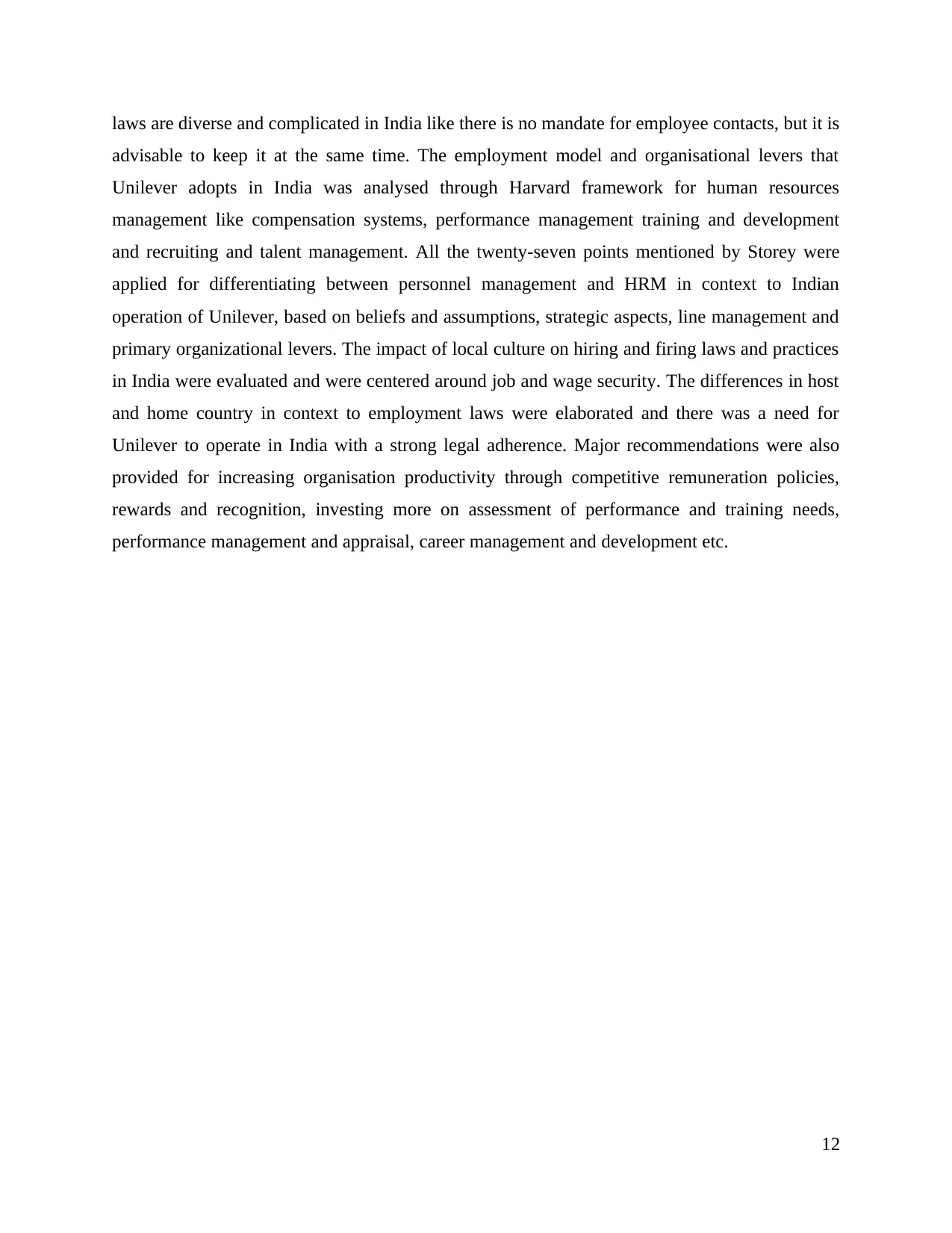
laws are diverse and complicated in India like there is no mandate for employee contacts, but it is
advisable to keep it at the same time. The employment model and organisational levers that
Unilever adopts in India was analysed through Harvard framework for human resources
management like compensation systems, performance management training and development
and recruiting and talent management. All the twenty-seven points mentioned by Storey were
applied for differentiating between personnel management and HRM in context to Indian
operation of Unilever, based on beliefs and assumptions, strategic aspects, line management and
primary organizational levers. The impact of local culture on hiring and firing laws and practices
in India were evaluated and were centered around job and wage security. The differences in host
and home country in context to employment laws were elaborated and there was a need for
Unilever to operate in India with a strong legal adherence. Major recommendations were also
provided for increasing organisation productivity through competitive remuneration policies,
rewards and recognition, investing more on assessment of performance and training needs,
performance management and appraisal, career management and development etc.
12
advisable to keep it at the same time. The employment model and organisational levers that
Unilever adopts in India was analysed through Harvard framework for human resources
management like compensation systems, performance management training and development
and recruiting and talent management. All the twenty-seven points mentioned by Storey were
applied for differentiating between personnel management and HRM in context to Indian
operation of Unilever, based on beliefs and assumptions, strategic aspects, line management and
primary organizational levers. The impact of local culture on hiring and firing laws and practices
in India were evaluated and were centered around job and wage security. The differences in host
and home country in context to employment laws were elaborated and there was a need for
Unilever to operate in India with a strong legal adherence. Major recommendations were also
provided for increasing organisation productivity through competitive remuneration policies,
rewards and recognition, investing more on assessment of performance and training needs,
performance management and appraisal, career management and development etc.
12
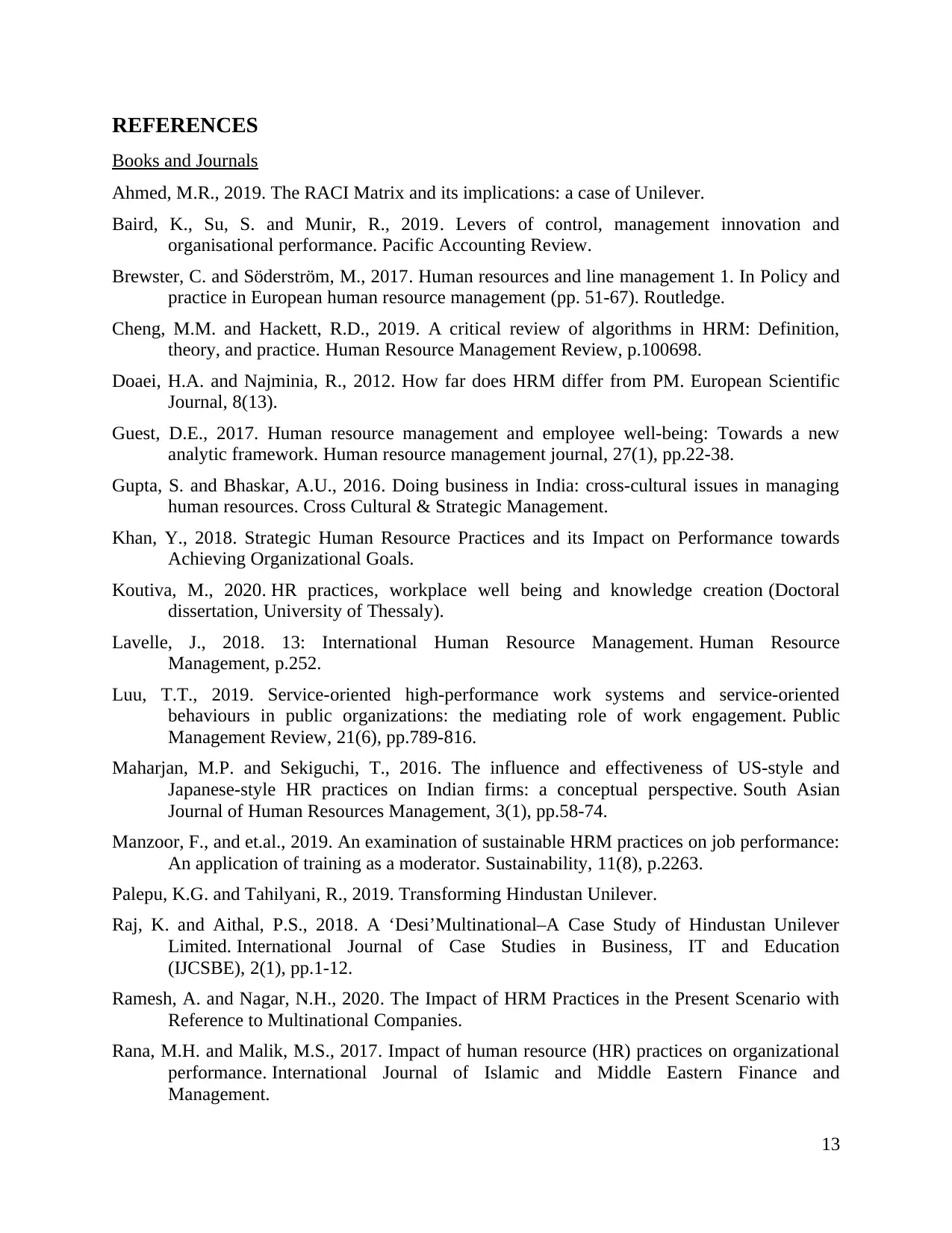
REFERENCES
Books and Journals
Ahmed, M.R., 2019. The RACI Matrix and its implications: a case of Unilever.
Baird, K., Su, S. and Munir, R., 2019. Levers of control, management innovation and
organisational performance. Pacific Accounting Review.
Brewster, C. and Söderström, M., 2017. Human resources and line management 1. In Policy and
practice in European human resource management (pp. 51-67). Routledge.
Cheng, M.M. and Hackett, R.D., 2019. A critical review of algorithms in HRM: Definition,
theory, and practice. Human Resource Management Review, p.100698.
Doaei, H.A. and Najminia, R., 2012. How far does HRM differ from PM. European Scientific
Journal, 8(13).
Guest, D.E., 2017. Human resource management and employee well‐being: Towards a new
analytic framework. Human resource management journal, 27(1), pp.22-38.
Gupta, S. and Bhaskar, A.U., 2016. Doing business in India: cross-cultural issues in managing
human resources. Cross Cultural & Strategic Management.
Khan, Y., 2018. Strategic Human Resource Practices and its Impact on Performance towards
Achieving Organizational Goals.
Koutiva, M., 2020. HR practices, workplace well being and knowledge creation (Doctoral
dissertation, University of Thessaly).
Lavelle, J., 2018. 13: International Human Resource Management. Human Resource
Management, p.252.
Luu, T.T., 2019. Service-oriented high-performance work systems and service-oriented
behaviours in public organizations: the mediating role of work engagement. Public
Management Review, 21(6), pp.789-816.
Maharjan, M.P. and Sekiguchi, T., 2016. The influence and effectiveness of US-style and
Japanese-style HR practices on Indian firms: a conceptual perspective. South Asian
Journal of Human Resources Management, 3(1), pp.58-74.
Manzoor, F., and et.al., 2019. An examination of sustainable HRM practices on job performance:
An application of training as a moderator. Sustainability, 11(8), p.2263.
Palepu, K.G. and Tahilyani, R., 2019. Transforming Hindustan Unilever.
Raj, K. and Aithal, P.S., 2018. A ‘Desi’Multinational–A Case Study of Hindustan Unilever
Limited. International Journal of Case Studies in Business, IT and Education
(IJCSBE), 2(1), pp.1-12.
Ramesh, A. and Nagar, N.H., 2020. The Impact of HRM Practices in the Present Scenario with
Reference to Multinational Companies.
Rana, M.H. and Malik, M.S., 2017. Impact of human resource (HR) practices on organizational
performance. International Journal of Islamic and Middle Eastern Finance and
Management.
13
Books and Journals
Ahmed, M.R., 2019. The RACI Matrix and its implications: a case of Unilever.
Baird, K., Su, S. and Munir, R., 2019. Levers of control, management innovation and
organisational performance. Pacific Accounting Review.
Brewster, C. and Söderström, M., 2017. Human resources and line management 1. In Policy and
practice in European human resource management (pp. 51-67). Routledge.
Cheng, M.M. and Hackett, R.D., 2019. A critical review of algorithms in HRM: Definition,
theory, and practice. Human Resource Management Review, p.100698.
Doaei, H.A. and Najminia, R., 2012. How far does HRM differ from PM. European Scientific
Journal, 8(13).
Guest, D.E., 2017. Human resource management and employee well‐being: Towards a new
analytic framework. Human resource management journal, 27(1), pp.22-38.
Gupta, S. and Bhaskar, A.U., 2016. Doing business in India: cross-cultural issues in managing
human resources. Cross Cultural & Strategic Management.
Khan, Y., 2018. Strategic Human Resource Practices and its Impact on Performance towards
Achieving Organizational Goals.
Koutiva, M., 2020. HR practices, workplace well being and knowledge creation (Doctoral
dissertation, University of Thessaly).
Lavelle, J., 2018. 13: International Human Resource Management. Human Resource
Management, p.252.
Luu, T.T., 2019. Service-oriented high-performance work systems and service-oriented
behaviours in public organizations: the mediating role of work engagement. Public
Management Review, 21(6), pp.789-816.
Maharjan, M.P. and Sekiguchi, T., 2016. The influence and effectiveness of US-style and
Japanese-style HR practices on Indian firms: a conceptual perspective. South Asian
Journal of Human Resources Management, 3(1), pp.58-74.
Manzoor, F., and et.al., 2019. An examination of sustainable HRM practices on job performance:
An application of training as a moderator. Sustainability, 11(8), p.2263.
Palepu, K.G. and Tahilyani, R., 2019. Transforming Hindustan Unilever.
Raj, K. and Aithal, P.S., 2018. A ‘Desi’Multinational–A Case Study of Hindustan Unilever
Limited. International Journal of Case Studies in Business, IT and Education
(IJCSBE), 2(1), pp.1-12.
Ramesh, A. and Nagar, N.H., 2020. The Impact of HRM Practices in the Present Scenario with
Reference to Multinational Companies.
Rana, M.H. and Malik, M.S., 2017. Impact of human resource (HR) practices on organizational
performance. International Journal of Islamic and Middle Eastern Finance and
Management.
13
Paraphrase This Document
Need a fresh take? Get an instant paraphrase of this document with our AI Paraphraser
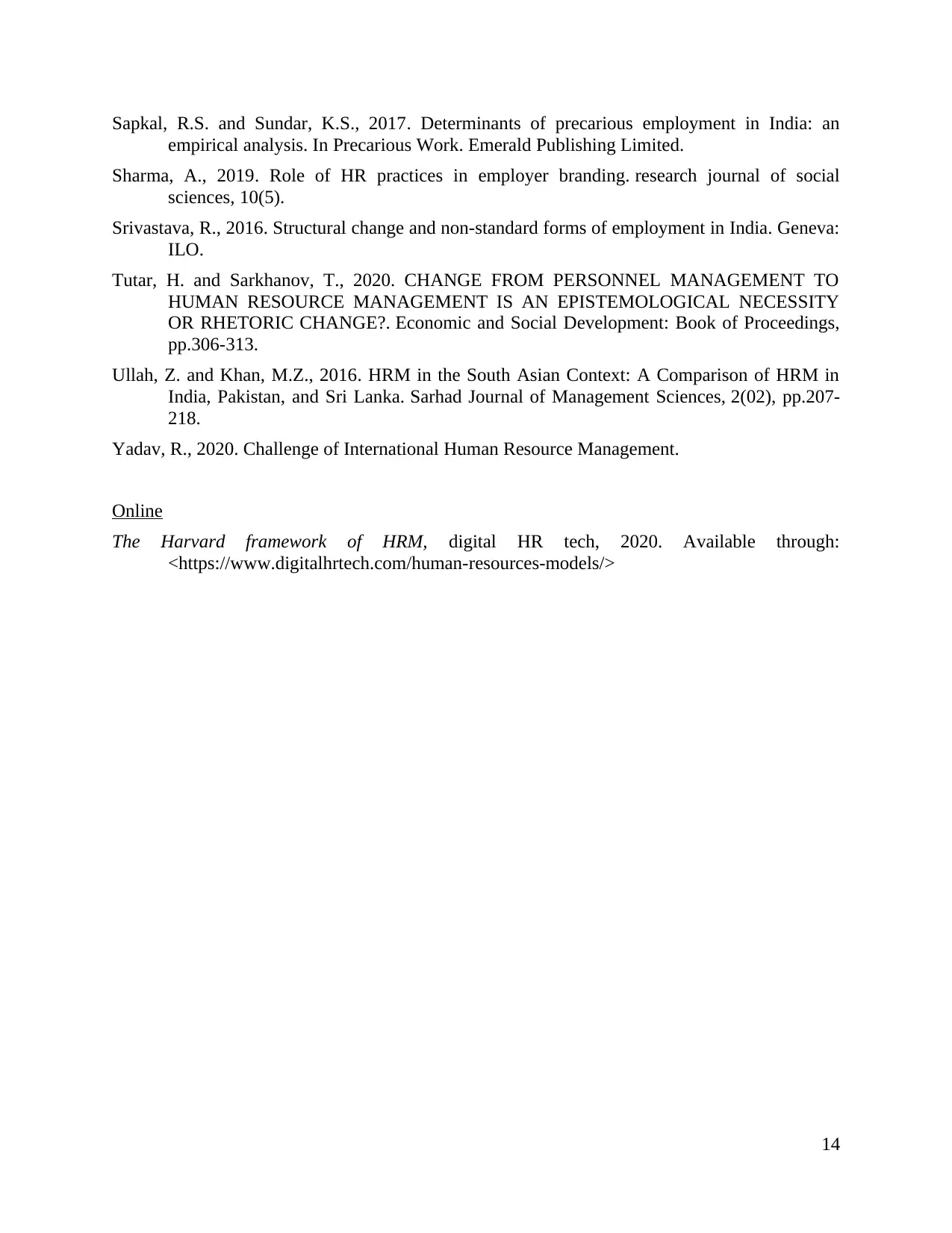
Sapkal, R.S. and Sundar, K.S., 2017. Determinants of precarious employment in India: an
empirical analysis. In Precarious Work. Emerald Publishing Limited.
Sharma, A., 2019. Role of HR practices in employer branding. research journal of social
sciences, 10(5).
Srivastava, R., 2016. Structural change and non-standard forms of employment in India. Geneva:
ILO.
Tutar, H. and Sarkhanov, T., 2020. CHANGE FROM PERSONNEL MANAGEMENT TO
HUMAN RESOURCE MANAGEMENT IS AN EPISTEMOLOGICAL NECESSITY
OR RHETORIC CHANGE?. Economic and Social Development: Book of Proceedings,
pp.306-313.
Ullah, Z. and Khan, M.Z., 2016. HRM in the South Asian Context: A Comparison of HRM in
India, Pakistan, and Sri Lanka. Sarhad Journal of Management Sciences, 2(02), pp.207-
218.
Yadav, R., 2020. Challenge of International Human Resource Management.
Online
The Harvard framework of HRM, digital HR tech, 2020. Available through:
<https://www.digitalhrtech.com/human-resources-models/>
14
empirical analysis. In Precarious Work. Emerald Publishing Limited.
Sharma, A., 2019. Role of HR practices in employer branding. research journal of social
sciences, 10(5).
Srivastava, R., 2016. Structural change and non-standard forms of employment in India. Geneva:
ILO.
Tutar, H. and Sarkhanov, T., 2020. CHANGE FROM PERSONNEL MANAGEMENT TO
HUMAN RESOURCE MANAGEMENT IS AN EPISTEMOLOGICAL NECESSITY
OR RHETORIC CHANGE?. Economic and Social Development: Book of Proceedings,
pp.306-313.
Ullah, Z. and Khan, M.Z., 2016. HRM in the South Asian Context: A Comparison of HRM in
India, Pakistan, and Sri Lanka. Sarhad Journal of Management Sciences, 2(02), pp.207-
218.
Yadav, R., 2020. Challenge of International Human Resource Management.
Online
The Harvard framework of HRM, digital HR tech, 2020. Available through:
<https://www.digitalhrtech.com/human-resources-models/>
14
1 out of 14
Related Documents
Your All-in-One AI-Powered Toolkit for Academic Success.
+13062052269
info@desklib.com
Available 24*7 on WhatsApp / Email
![[object Object]](/_next/static/media/star-bottom.7253800d.svg)
Unlock your academic potential
© 2024 | Zucol Services PVT LTD | All rights reserved.





